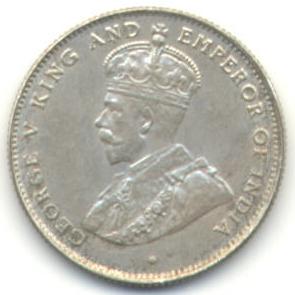
By order in Council dated 1919 May 8th following the increase in the price of silver after World War I(1914-1918), the fineness standard of the Ceylon silver coins was reduced from .800 parts to .550.
The obverse of the coin carries crowned Head to left in relief in center of the legend GEORGE V KING AND EMPEROR OF INDIA Initials of designer B.M. in relief on the truncation of the shoulder put in by designer Sir Edgar Bertram Mackennal.
The reverse of the coin (except 5 cemts) is a talipot palm (coryply aumbraceulifera) or fan palm, a prominent palm species of Ceylon. The name CEYLON above and the year of issue below. The value in Sinhala and Tamil on either side. The Sinhala text is to the right on the silver and to the left on the nickel and copper coins.

| ||||
| KM106 | Half | Cent | copper | coin |
| KM107 | One | Cent | copper | coin |
| KM108 | Five | Cent | cupro-nickel | coin |
| KM104 | Ten | Cent | silver | coin |
| KM105 | TwentyFive | Cent | silver | coin |
| KM109 | Fifty | Cent | silver | coin |
It is interesting to note that Indian Silver and copper coins of George V like thos of George VI do not have OF INDIA, like seen on Ceylon and most other commonwealth nations maybe because INDIA is already mentioned on Indian coins. Those which were already independent which used IND. IMP as on British coins. Edward VII also used no OF INDIA on any coins I presume as he was considered Emperor of the British Empire.
All coins produced during the reign of King George V minted for use in colonial and commonwealth locations use a crowned head while issues designed for use in the U.K. feature an uncrowned head. When George VI assumed the throne and new coins began to appear bearing his image, this basic pattern seems to have changed. For example, coins produced for use in places such as South Africa, Canada, Australia, and New Zealand used the same bare-headed image of the king as those minted for use in the U.K. Those for other places --- for instance British West Africa, British Honduras, and Ceylon --- featured a crowned head image of the king.
Text edited from
* The Coins of the British Commonwealth of Nations
F. Pridmore, London, Spink & Son Ltd., 1960.